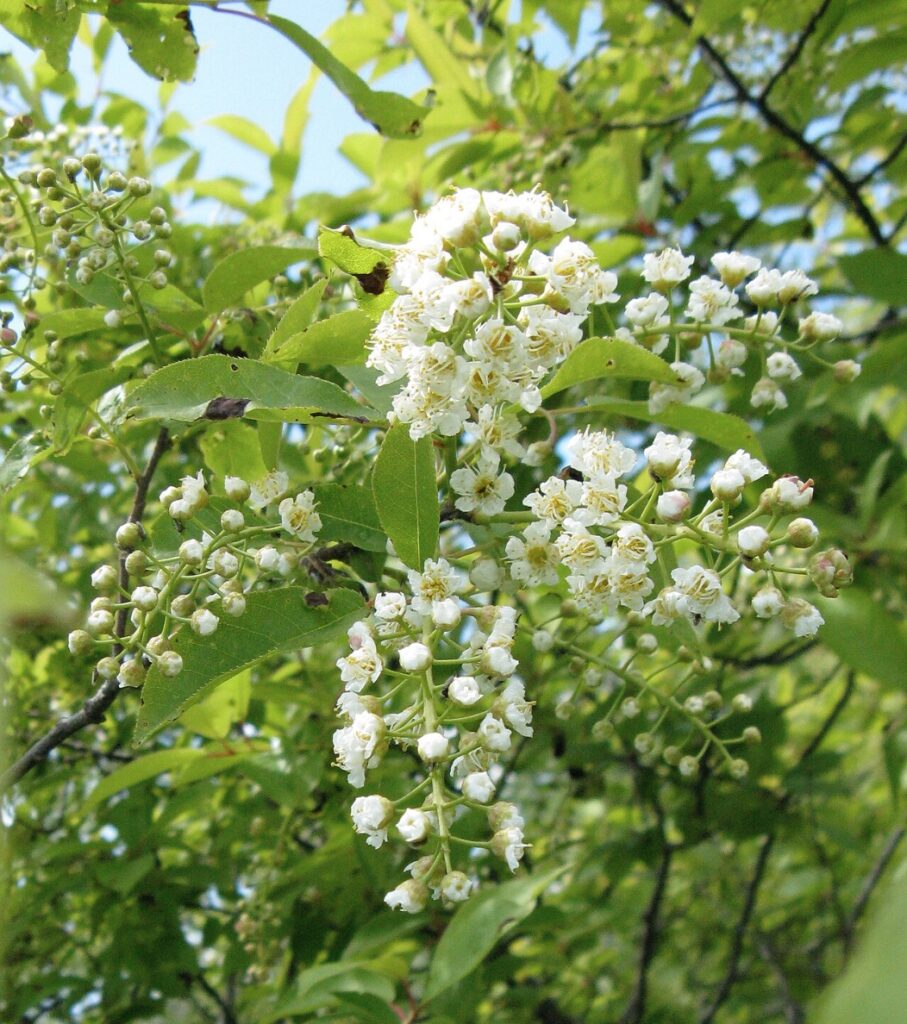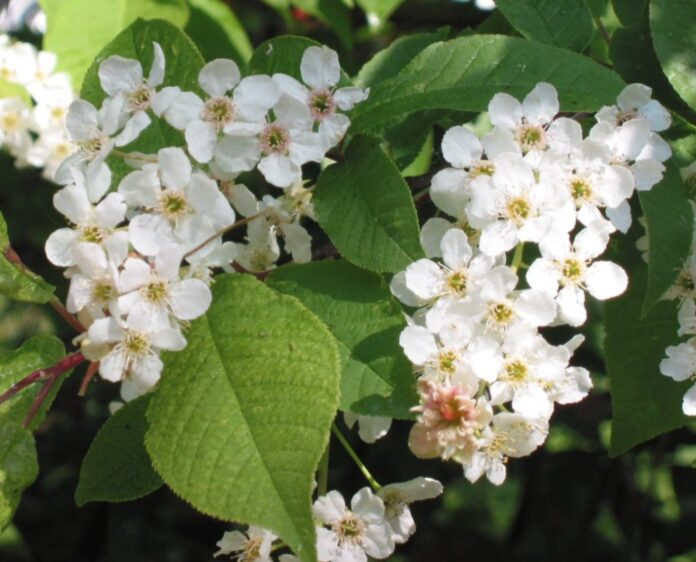The Alaska Division of Agriculture has issued a statewide quarantine on two invasive tree species—Prunus padus, known as the European Bird Cherry or Mayday tree, and Prunus virginiana, commonly called the Canada Red or Chokecherry tree.
Effective Sept. 1, the order prohibits the importation, transport, and sale of both species and their parts. State officials say the trees are rapidly spreading in Alaska’s riparian zones and forests, creating monocultures that displace native vegetation and threaten fish and wildlife habitat.
The trees have established themselves across multiple regions, including the Fairbanks North Star Borough, Matanuska-Susitna Borough, Anchorage, the Kenai Peninsula, and Juneau.

These species have been documented along creeks and streams, where they reduce insect biomass critical to juvenile salmon, said Bryan Scoresby, Director of the Division of Agriculture. “Many agencies continue to pursue control measures with the goal of eliminating these invasive trees. With this quarantine, the flow of trees into Alaska will stop, making this goal more attainable.”
The invasive Prunus species not only compete with native plants but also pose direct risks to Alaska’s wildlife. They contain a cyanogenic glycoside that is toxic to ruminants such as moose when consumed, reducing the availability of safe winter forage.
In addition, researchers recently detected the fungal disease “Black Knot” (Apiosporina morbosa) on European Bird Cherry trees at the University of Alaska Anchorage campus. Black Knot is a serious threat to fruit tree cultivation, especially plums and cherries, and invasive Prunus trees are a potential vector for its spread.
Over the past five years, the Department of Natural Resources’ Division of Forestry & Fire Protection has invested more than $400,000 in control measures across Alaska’s largest boroughs. The agency has also led public outreach campaigns through community meetings, media coverage, and radio ads to warn Alaskans about the risks of invasive Prunus trees. An additional $250,000 has been committed to current projects aimed at eradication.
The Department of Natural Resources said that protecting native ecosystems aligns with its mission to develop, conserve, and maximize the use of Alaska’s natural resources in the public interest.

When these fiendish plants decompose they spread ‘micro cherry’ particles through EVERYTHING! If we want to stop this hellish plague we must surrender all of our rights to our scientific betters. When have they ever lied to us about anything?
Invasive would mean they are aggressively spreading such as vetch has been for quite awhile. I have lived in the same house for 35 years and have three such trees. All close to 40 years old. I have seen zero reseeding anywhere nor do the trees ever reseed in the yard. Add also we have a small apple orchard of also very mature trees, completely unaffected by their prunus yard-mates. I think this is a lot of misguided hoopla. If the state would like to remove my large trees and replace them with an ornamental alternative in beauty and size at state expense, then have at it. I have hiked extensively, and boated, all over south central Alaska and have yet to see a Mayday or Chokecherry self propagated by errant seed anywhere. Perhaps some publicly shared visual and locational documentation would help with acceptance of what seems pretty knee jerky reaction.
Agreed. My trees seem to stay right where they were planted. Never seen sign of spreading. I have also never seen them in the wild. Apparently along some creeks in Anchorage they’re a problem. Therefore they must be banned of course. Well they can pry my Chokecherry trees from my cold dead fingers!!!
The trees were planted across Fairbanks in the 1950s and ’60s, and they have established a few trees along waterways where the ground has been tore up and turf and fertilizer out in.
What a joke to spend even $100k, much less $400k for something that isn’t a big deal at all.
I’ve had chokecherry trees around my house for 70 years, and they are lovely hardwoods. I will be planting more of them in as many locations as I can. Happy salmon fishing!
I’m busy planting more chokecherry trees today. They are so lovely.
Right… Choke Cherries have been sold for years as rapidly-growing noise & sight barriers in the Fairbanks area. Moose eat both berries and new growth with no apparent ill effects. New shoots are easily controlled with a lawn-mower.
Looks like another agency looking for control and budget pruning avoidance. They’ve lost the battle against invasive weeds, so now they want to loose another round on trees…
Outrageous!! A clear example of government overreach! We demand the FREEDOM to take whatever vaccines we choose, including none at all, to openly carry our firearms wherever and whenever we wish, to obtain our energy from any source whatsoever, no matter how polluting, and to GROW THE TYPES OF TREES WE DESIRE, whether or not they damage the environment.
RISE UP against this tyranny my MAGA brothers and sisters, for your RIGHTS are being TRAMPLED upon!
Well stated. You got your marching orders from the UAF transexual, doctoral biology student. Now, go take another sleeping pill and come back after you cut down all of your chokecherry trees. Then you can commence fishing for salmon in your backyard.
Lighten up, Francis.
One of the best things about living in the Interior is the chokecherrys blooming in the Springtime. Moose know to leave them alone. Birds love them.
The state declares: “…where they reduce insect biomass critical to juvenile salmon…” My direct observation of chokecherries is LOTS of insects love them- way more than a black spruce.
I was confused about that too, since these trees seem to attract large numbers of bees other pollinators. Mayday and chokecherry trees have been present in the Fairbanks and Anchorage areas for many decades.
They attract birds also, as you will find out if you park under one when the cherries are ripe.
If evolution is real then why worry about invasive species at all? The salmon and the insects will evolve and thrive. Right evolutionist?
Well, Wibley, don’t you know that imitation is the sincerest form of flattery?
We truly think that you have mental illness, Whidbey.
I hate that stupid Bird Cherry tree, especially when it is stinking while in bloom.
I kill them whenever I find the seedlings in the wild.
Why are we not surprised?
Technoc-rats aka globalist want humans gone. Taking away our freedom one razor cut at a time while sneaking in their web of spy networks. Say no to Real IDs, say no to 15 minute cities, say no to leftist plans to make us all into their surfs! Say no to fluoridated water which is dumbing down children and making everyone passive, slowly poisoning us.
To Representative Kevin McCabe who advocates for a standalone Department of Agriculture, does this story not offer a good example of the idiocy and arrogance that insures a standalone Department of Agriculture will never be more than another burdensome bureaucratic drag on Alaska’s people and economy?
.
“Invasive species”? Maybe we should be talking about bum camps instead of cherry trees, how effectively the government order prohibiting the importation, transport, and sale of that invasive species is working?
.
Would it be like an insurrection or something to suggest the Peoples’ Department of Agriculture shove their order where the sun doesn’t shine because they seem just as useless and panic-stricken as the Peoples’ Department of Health?
I’ll write this slowly so the “Give me choke cherry trees or give me death” contingent can comprehend. Chokecherry is an invasive species. People who claim to love Alaska should understand that one simple concept. “Should”. But we know better. And the gasses produced KILL moose when they ingest enough of the plant. Moose do not intrinsically know to leave it alone. They browse, they get sick, and if lucky, they learn. That behavior can be learned by subsequent generations, but over the years I’ve personally opened up several severely bloated late season calves laying by chokecherry trees and got blasted with the sickly sweet odor of cyanide gas. Belly full of chokecherry browse. Bummer way to die. “But it’s so pretty!”
The moose in my yard that browse on choke cherry come back for more – with no apparent ill effect. I’m not wedded to my landscaping (the trees came with the lot when I bought it…). I’m just tired of hysteria and artificial attempts at creating crises to manipulate people into approving appropriations that benefit the “researchers”. These same people swear evolution is true, and that some how we have to direct “evolutionary progress” by protecting favored species. Sound bite version: BULL SH**!
Hysteria – plant police!! 🙄 they ignore the more harsh an area s climate is fewer b. Cherry trees will be seen. Ban the entire state of a tree that survives and thrives! Other than a little pruning there’s no other work needed to keep them going for decades!
Hysteria – plant police!! 🙄 they ignore the more harsh an area s climate is fewer b. Cherry trees will be seen. Ban the entire state of a tree that survives and thrives! Other than a little pruning there’s no other work needed to keep them going for decades! Their common Mantra “save the baby salmon” no matter the topic!
Backyard is full of them.
Nice barrier plant.
I can’t see any good reason not to have them.
I mean really.